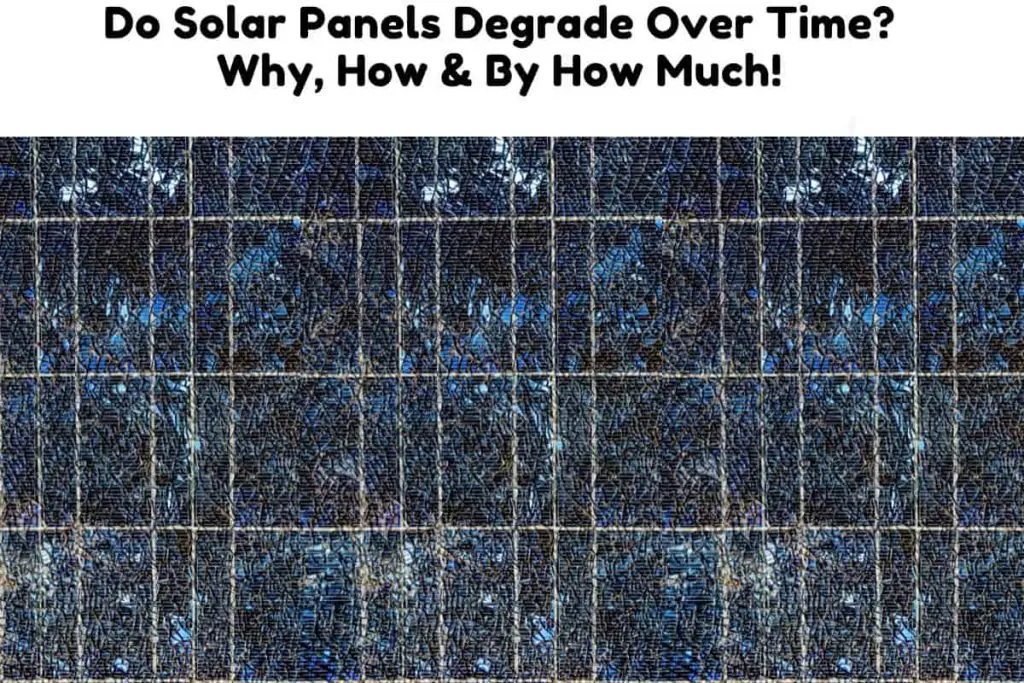Solar panels last up to 25 years. But how do they perform throughout their lifetime? Do they suffer from a decline in their performance as they get older?
Solar panels do degrade over time. They become less efficient over their lifespan with the result that a solar panel in its 25th year does not produce as much energy as it did in its first year of operation.
In this article, we will examine how fast solar panel degradation occurs and why it happens. We will also look at what happens to solar panel efficiency as well as how long the average solar panel lasts.
If you want to know how much energy a solar panel is likely to produce at the 15-, 20- or 25-year mark then this article has the answer for you so keep reading.
On a side note! If you’re in need of a reliable and high-performance portable solar panel, We strongly recommend the Jackery SolarSaga 100W Portable Solar Panel (Amazon Link).
With a high conversion efficiency and foldable design, this solar panel is easy to transport and set up, making it perfect for outdoor activities like camping, hiking, and RV trips.

The US solar cell technology used in this panel ensures that you get the most efficient and reliable solar charging possible.
There is also a 60W option that is more affordable (Amazon Link)

How Long Do Average Solar Panels Last?
Solar panels have warranties for 25 years. While their sticker lifespan is 25 years, in reality, solar panels can last even longer than that. There are solar panels that are over 40 years old that are still in operation.
Most solar manufacturers guarantee their solar panels for 25 years. This does not necessarily mean the solar panel will work for those exact number of years and then die on you. 80% of solar panels last longer than their warranty according to a study by the National Renewable Energy Laboratory (NREL). (Source)
Do Solar Panels Become Less Efficient Over Time?
While solar panels have a long lifespan, they gradually become less efficient over time. This loss in efficiency is caused by heat and primarily by solar panel degradation.
A solar panel’s efficiency is a measure of how much sunlight it converts into electricity. Solar panels absorb only 30% of sunlight. The rest is reflected in the atmosphere. Of the small percentage of light that is absorbed by a solar panel, only a fraction is converted into electricity.
There are three main types of solar panels available on the market today. They are monocrystalline, polycrystalline, and thin-film solar panels. The major difference between them is in how they are made, what they look like and of course their efficiency.
Monocrystalline solar panels are made from a single crystal of silicon, have a black color, and are the most efficient. Polycrystalline solar panels are made from multiple pieces of silicon, have a blue color, and are slightly less efficient.
Thin-film solar panels are made from various substances like Cadmium and are black. They typically have a lower efficiency than either mono or polycrystalline although thin-film panels with improved efficiencies are starting to find their way to the market.
| Solar panel type | Efficiency |
| Monocrystalline | 22-27% |
| Polycrystalline | 15-22% |
| Thin Film | 15-22% |
For more on Solar Panel types, we recommend that you check out our post Monocrystalline Vs Polycrystalline Vs Thin-film Solar Panels – Which Is Better!
What Affects the Efficiency of A Solar Panel?
The type of solar panel determines its overall efficiency. Thus, you have monocrystalline delivering the best efficiency compared to the polycrystalline and thin film. Aside from type, two other factors can affect efficiency, namely temperature, and degradation. (Source)
Temperature reduces the efficiency of a solar panel. Contrary to what most people believe, heat is bad for a solar panel. The hotter a solar panel gets the less energy it produces. This is known as the temperature coefficient of a solar panel. Every 1°C rise in temperature over 25°C reduces the solar panel’s output.
Solar panels also degrade over time and this reduces their efficiency. Why does this happen or what causes it to occur?
What Causes Solar Panel Degradation?
The primary causes of solar panel degradation are thermal shock, heat, and humidity as well as exposure to light, weather elements, and deterioration of the components in the panel over time.
Thermal shock
Solar panels are exposed to extreme heat and cold. Rapidly cycling from hot to cold or cold to hot can crack the glass covering the solar panel or damage the solar cells themselves. For more on this, check out What Is Solar Panel Glass Made Of & Why ?!
Degradation from exposure to light
It might seem strange that a solar panel degrades because of exposure to light. After all solar panels produce energy using light. So how is it that the same conditions from which they produce energy are the same conditions that cause them to deteriorate?
Light-induced degradation or LID occurs when the solar panel is set up for the first time. The electronics in the solar cells can warp from the first exposure to heat. This happens in the first 1000 hours of operation and reduces the solar panel’s efficiency by 1-3%.
UV light-induced degradation or UVID occurs when exposure to sunlight causes the crystalline silicon oxide on the panel’s surface to form a layer of boron dioxide that reduces its efficiency. UV exposure can also damage the back cover of the solar panel. (Source)
Age-related degradation
This is the natural wear and tear of the solar panel owing to it being exposed to weather elements. A solar panel experiences extremes in heat, cold, and humidity. This can harm the solar panel by way of chemical and mechanical reactions from the silicon or the other materials that constitute the solar panel.
Rain and snowfall can cause the silicon to harden and the frame of the solar panel to corrode. Hail and dust storms can cause microcracks on the surface of the panel. (Source)
Also, find out ” Do Solar Panels Work with Snow on Them?“
Potential-induced degradation or PID
Although less common than other causes, this can reduce a solar panel’s performance by 30%. PID occurs as a result of a difference in voltage between the components of a solar panel. This could be a difference between the solar cells and the frame of the panel. This causes voltage leaks that reduce the solar panel’s output.
How Quickly Do Solar Panels Degrade?
Solar panels degrade at a rate of between 0.5% to 0.8% according to the results published by the National Renewable Energy Laboratory (NREL). Throughout a 25-year lifespan, a solar panel will lose up to 20% of its efficiency.
What this means is a solar panel with an efficiency of 300 watts will still produce up to 240 watts at 80% efficiency. The best ways to slow down the rate of degradation are by ensuring your solar panel is not shaded and by keeping it clean.
